Weight Initializations & Activation Functions¶
Run Jupyter Notebook
You can run the code for this section in this jupyter notebook link.
Recap of Logistic Regression¶
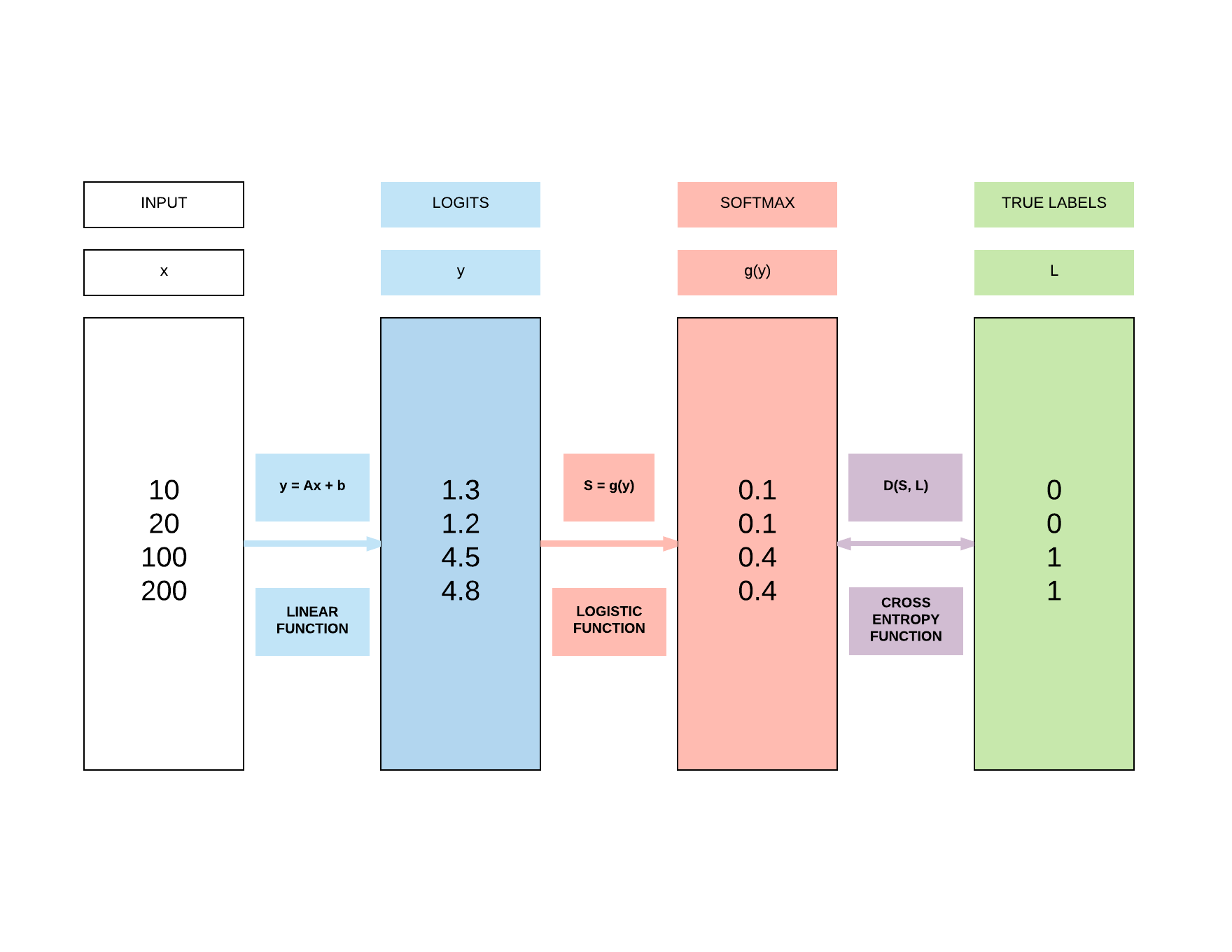
Recap of Feedforward Neural Network Activation Function¶
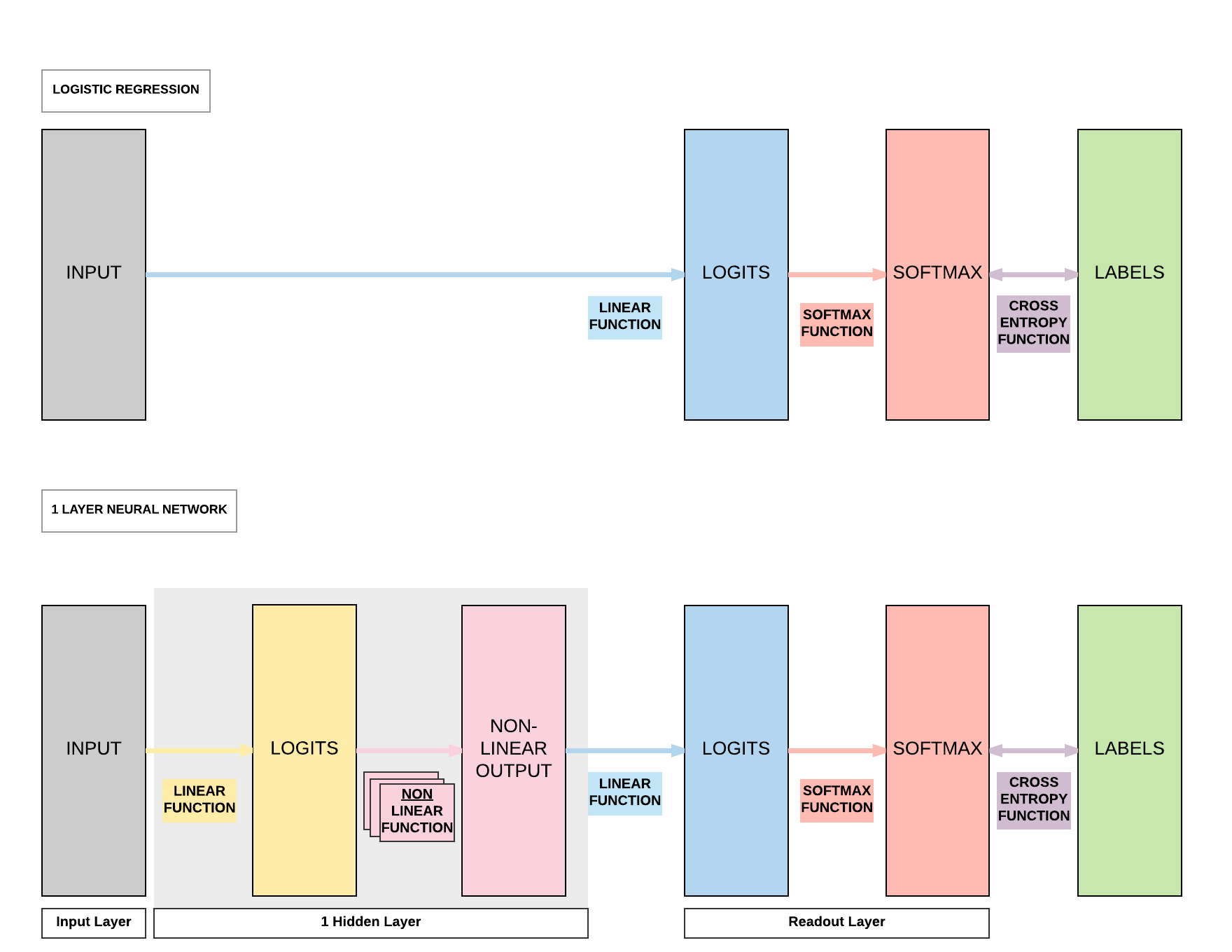
Sigmoid (Logistic)¶
- \(\sigma(x) = \frac{1}{1 + e^{-x}}\)
- Input number \(\rightarrow\) [0, 1]
- Large negative number \(\rightarrow\) 0
- Large positive number \(\rightarrow\) 1
- Cons:
- Activation saturates at 0 or 1 with gradients \(\approx\) 0
- No signal to update weights \(\rightarrow\) cannot learn
- Solution: Have to carefully initialize weights to prevent this
- Activation saturates at 0 or 1 with gradients \(\approx\) 0
import matplotlib.pyplot as plt
%matplotlib inline
import numpy as np
def sigmoid(x):
a = []
for item in x:
a.append(1/(1+np.exp(-item)))
return a
x = np.arange(-10., 10., 0.2)
sig = sigmoid(x)
plt.style.use('ggplot')
plt.plot(x,sig, linewidth=3.0)
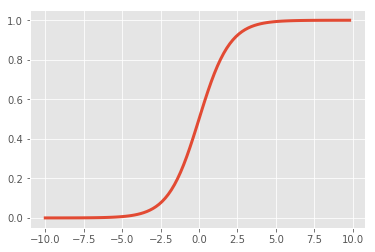
Tanh¶
- \(\tanh(x) = 2 \sigma(2x) -1\)
- A scaled sigmoid function
- Input number \(\rightarrow\) [-1, 1]
- Cons:
- Activation saturates at 0 or 1 with gradients \(\approx\) 0
- No signal to update weights \(\rightarrow\) cannot learn
- Solution: Have to carefully initialize weights to prevent this
- Activation saturates at 0 or 1 with gradients \(\approx\) 0
x = np.arange(-10., 10., 0.2)
tanh = np.dot(2, sigmoid(np.dot(2, x))) - 1
plt.plot(x,tanh, linewidth=3.0)
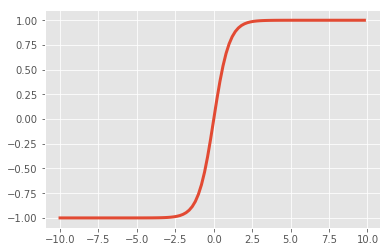
ReLUs¶
- \(f(x) = \max(0, x)\)
- Pros:
- Accelerates convergence \(\rightarrow\) train faster
- Less computationally expensive operation compared to Sigmoid/Tanh exponentials
- Cons:
- Many ReLU units "die" \(\rightarrow\) gradients = 0 forever
- Solution: careful learning rate and weight initialization choice
- Many ReLU units "die" \(\rightarrow\) gradients = 0 forever
x = np.arange(-10., 10., 0.2)
relu = np.maximum(x, 0)
plt.plot(x,relu, linewidth=3.0)
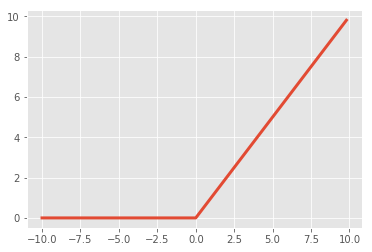
Why do we need weight initializations or new activation functions?¶
- To prevent vanishing/exploding gradients
Case 1: Sigmoid/Tanh¶
- Problem
- If variance of input too large: gradients = 0 (vanishing gradients)
- If variance of input too small: linear \(\rightarrow\) gradients = constant value
- Solutions
- Want a constant variance of input to achieve non-linearity \(\rightarrow\) unique gradients for unique updates
- Xavier Initialization (good constant variance for Sigmoid/Tanh)
- ReLU or Leaky ReLU
- Want a constant variance of input to achieve non-linearity \(\rightarrow\) unique gradients for unique updates
Case 2: ReLU¶
- Solution to Case 1
- Regardless of variance of input: gradients = 0 or 1
- Problem
- But those with 0: no updates ("dead ReLU units")
- Has unlimited output size with input > 0 (explodes gradients subsequently)
- Solutions
- He Initialization (good constant variance)
- Leaky ReLU
Case 3: Leaky ReLU¶
- Solution to Case 2
- Solves the 0 signal issue when input < 0

- Solves the 0 signal issue when input < 0
- Problem
- Has unlimited output size with input > 0 (explodes)
- Solution
- He Initialization (good constant variance)
Summary of weight initialization solutions to activations¶
- Tanh/Sigmoid vanishing gradients can be solved with Xavier initialization
- Good range of constant variance
- ReLU/Leaky ReLU exploding gradients can be solved with He initialization
- Good range of constant variance
Types of weight intializations¶
Zero Initialization: set all weights to 0¶
- Every neuron in the network computes the same output \(\rightarrow\) computes the same gradient \(\rightarrow\) same parameter updates
Normal Initialization: set all weights to random small numbers¶
- Every neuron in the network computes different output \(\rightarrow\) computes different gradient \(\rightarrow\) different parameter updates
- "Symmetry breaking"
- Problem: variance that grows with the number of inputs
Lecun Initialization: normalize variance¶
- Solves growing variance with the number of inputs \(\rightarrow\) constant variance
- Look at a simple feedforward neural network
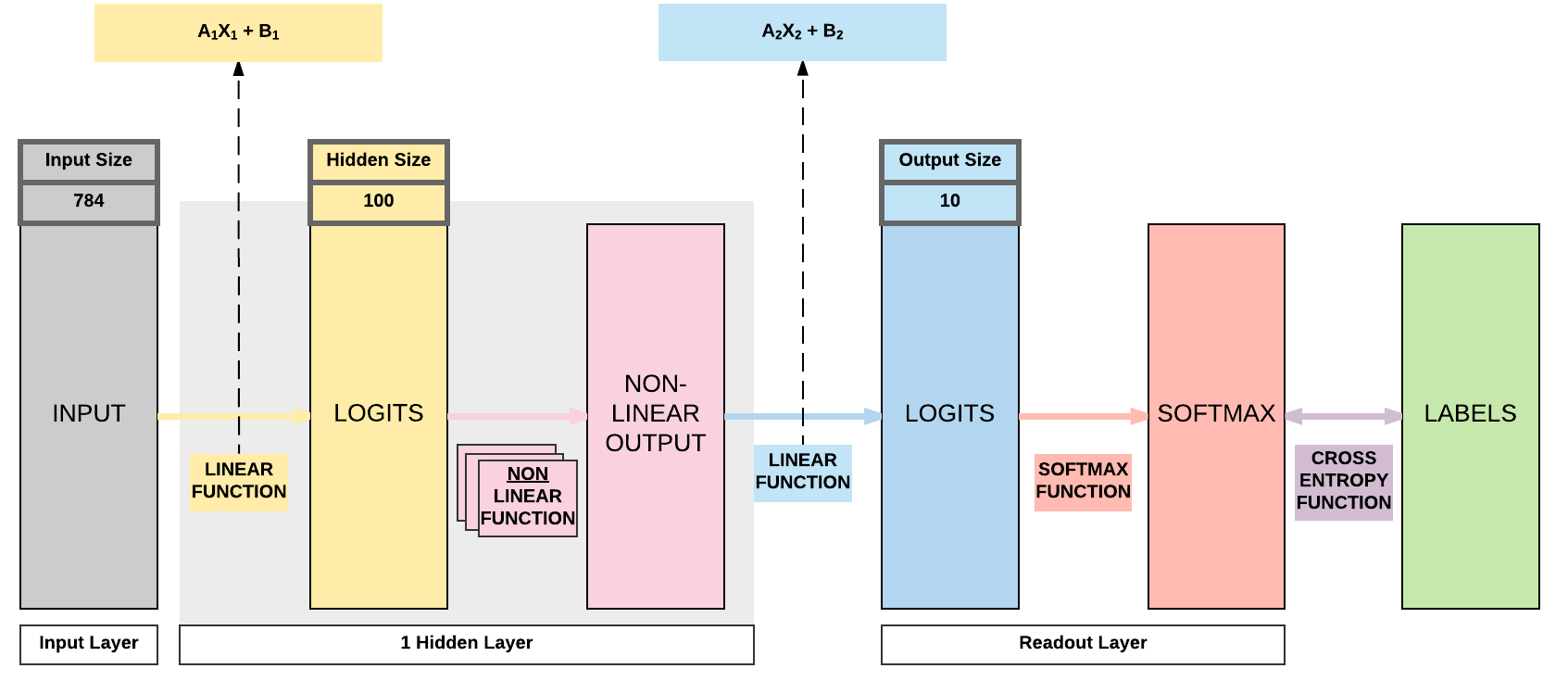
Equations for Lecun Initialization¶
- \(Y = AX + B\)
- \(y = a_1x_1 + a_2x_2 + \cdot + a_n x_n + b\)
- \(Var(y) = Var(a_1x_1 + a_2x_2 + \cdot + a_n x_n + b)\)
- \(Var(a_i x_i) = E(x_i)^2 Var(a_i) + E(a_i)^2Var(x_i) + Var(a_i)Var(x_i)\)
- General term, you might be more familiar with the following
- \(Var(XY) = E(X)^2 Var(Y) + E(Y)^2Var(X) + Var(X)Var(Y)\)
- \(E(x_i)\): expectation/mean of \(x_i\)
- \(E(a_i)\): expectation/mean of \(a_i\)
- General term, you might be more familiar with the following
- Assuming inputs/weights drawn i.i.d. with Gaussian distribution of mean=0
- \(E(x_i) = E(a_i) = 0\)
- \(Var(a_i x_i) = Var(a_i)Var(x_i)\)
- \(Var(y) = Var(a_1)Var(x_1) + \cdot + Var(a_n)Var(x_n)\)
- Since the bias, b, is a constant, \(Var(b) = 0\)
- Since i.i.d.
- \(Var(y) = n \times Var(a_i)Var(x_i)\)
- Since we want constant variance where \(Var(y) = Var(x_i)\)
- \(1 = nVar(a_i)\)
- \(Var(a_i) = \frac{1}{n}\)
- This is essentially Lecun initialization, from his paper titled "Efficient Backpropagation"
- We draw our weights i.i.d. with mean=0 and variance = \(\frac{1}{n}\)
- Where \(n\) is the number of input units in the weight tensor
Improvements to Lecun Intialization¶
- They are essentially slight modifications to Lecun'98 initialization
- Xavier Intialization
- Works better for layers with Sigmoid activations
- \(var(a_i) = \frac{1}{n_{in} + n_{out}}\)
- Where \(n_{in}\) and \(n_{out}\) are the number of input and output units in the weight tensor respectively
- Kaiming Initialization
- Works better for layers with ReLU or LeakyReLU activations
- \(var(a_i) = \frac{2}{n_{in}}\)
Summary of weight initializations¶
- Normal Distribution
- Lecun Normal Distribution
- Xavier (Glorot) Normal Distribution
- Kaiming (He) Normal Distribution
Weight Initializations with PyTorch¶
Normal Initialization: Tanh Activation¶
import torch
import torch.nn as nn
import torchvision.transforms as transforms
import torchvision.datasets as dsets
from torch.autograd import Variable
# Set seed
torch.manual_seed(0)
# Scheduler import
from torch.optim.lr_scheduler import StepLR
'''
STEP 1: LOADING DATASET
'''
train_dataset = dsets.MNIST(root='./data',
train=True,
transform=transforms.ToTensor(),
download=True)
test_dataset = dsets.MNIST(root='./data',
train=False,
transform=transforms.ToTensor())
'''
STEP 2: MAKING DATASET ITERABLE
'''
batch_size = 100
n_iters = 3000
num_epochs = n_iters / (len(train_dataset) / batch_size)
num_epochs = int(num_epochs)
train_loader = torch.utils.data.DataLoader(dataset=train_dataset,
batch_size=batch_size,
shuffle=True)
test_loader = torch.utils.data.DataLoader(dataset=test_dataset,
batch_size=batch_size,
shuffle=False)
'''
STEP 3: CREATE MODEL CLASS
'''
class FeedforwardNeuralNetModel(nn.Module):
def __init__(self, input_dim, hidden_dim, output_dim):
super(FeedforwardNeuralNetModel, self).__init__()
# Linear function
self.fc1 = nn.Linear(input_dim, hidden_dim)
# Linear weight, W, Y = WX + B
nn.init.normal_(self.fc1.weight, mean=0, std=1)
# Non-linearity
self.tanh = nn.Tanh()
# Linear function (readout)
self.fc2 = nn.Linear(hidden_dim, output_dim)
nn.init.normal_(self.fc2.weight, mean=0, std=1)
def forward(self, x):
# Linear function
out = self.fc1(x)
# Non-linearity
out = self.tanh(out)
# Linear function (readout)
out = self.fc2(out)
return out
'''
STEP 4: INSTANTIATE MODEL CLASS
'''
input_dim = 28*28
hidden_dim = 100
output_dim = 10
model = FeedforwardNeuralNetModel(input_dim, hidden_dim, output_dim)
'''
STEP 5: INSTANTIATE LOSS CLASS
'''
criterion = nn.CrossEntropyLoss()
'''
STEP 6: INSTANTIATE OPTIMIZER CLASS
'''
learning_rate = 0.1
optimizer = torch.optim.SGD(model.parameters(), lr=learning_rate, momentum=0.9, nesterov=True)
'''
STEP 7: INSTANTIATE STEP LEARNING SCHEDULER CLASS
'''
# step_size: at how many multiples of epoch you decay
# step_size = 1, after every 2 epoch, new_lr = lr*gamma
# step_size = 2, after every 2 epoch, new_lr = lr*gamma
# gamma = decaying factor
scheduler = StepLR(optimizer, step_size=1, gamma=0.96)
'''
STEP 8: TRAIN THE MODEL
'''
iter = 0
for epoch in range(num_epochs):
# Decay Learning Rate
scheduler.step()
# Print Learning Rate
print('Epoch:', epoch,'LR:', scheduler.get_lr())
for i, (images, labels) in enumerate(train_loader):
# Load images as tensors with gradient accumulation abilities
images = images.view(-1, 28*28).requires_grad_()
# Clear gradients w.r.t. parameters
optimizer.zero_grad()
# Forward pass to get output/logits
outputs = model(images)
# Calculate Loss: softmax --> cross entropy loss
loss = criterion(outputs, labels)
# Getting gradients w.r.t. parameters
loss.backward()
# Updating parameters
optimizer.step()
iter += 1
if iter % 500 == 0:
# Calculate Accuracy
correct = 0
total = 0
# Iterate through test dataset
for images, labels in test_loader:
# Load images to a Torch Variable
images = images.view(-1, 28*28)
# Forward pass only to get logits/output
outputs = model(images)
# Get predictions from the maximum value
_, predicted = torch.max(outputs.data, 1)
# Total number of labels
total += labels.size(0)
# Total correct predictions
correct += (predicted.type(torch.FloatTensor).cpu() == labels.type(torch.FloatTensor)).sum()
accuracy = 100. * correct.item() / total
# Print Loss
print('Iteration: {}. Loss: {}. Accuracy: {}'.format(iter, loss.item(), accuracy))
Epoch: 0 LR: [0.1]
Iteration: 500. Loss: 0.5192779302597046. Accuracy: 87.9
Epoch: 1 LR: [0.096]
Iteration: 1000. Loss: 0.4060308337211609. Accuracy: 90.15
Epoch: 2 LR: [0.09216]
Iteration: 1500. Loss: 0.2880493104457855. Accuracy: 90.71
Epoch: 3 LR: [0.08847359999999999]
Iteration: 2000. Loss: 0.23173095285892487. Accuracy: 91.99
Epoch: 4 LR: [0.084934656]
Iteration: 2500. Loss: 0.23814399540424347. Accuracy: 92.32
Iteration: 3000. Loss: 0.19513173401355743. Accuracy: 92.55
Lecun Initialization: Tanh Activation¶
- By default, PyTorch uses Lecun initialization, so nothing new has to be done here compared to using Normal, Xavier or Kaiming initialization.
import torch
import torch.nn as nn
import torchvision.transforms as transforms
import torchvision.datasets as dsets
from torch.autograd import Variable
# Set seed
torch.manual_seed(0)
# Scheduler import
from torch.optim.lr_scheduler import StepLR
'''
STEP 1: LOADING DATASET
'''
train_dataset = dsets.MNIST(root='./data',
train=True,
transform=transforms.ToTensor(),
download=True)
test_dataset = dsets.MNIST(root='./data',
train=False,
transform=transforms.ToTensor())
'''
STEP 2: MAKING DATASET ITERABLE
'''
batch_size = 100
n_iters = 3000
num_epochs = n_iters / (len(train_dataset) / batch_size)
num_epochs = int(num_epochs)
train_loader = torch.utils.data.DataLoader(dataset=train_dataset,
batch_size=batch_size,
shuffle=True)
test_loader = torch.utils.data.DataLoader(dataset=test_dataset,
batch_size=batch_size,
shuffle=False)
'''
STEP 3: CREATE MODEL CLASS
'''
class FeedforwardNeuralNetModel(nn.Module):
def __init__(self, input_dim, hidden_dim, output_dim):
super(FeedforwardNeuralNetModel, self).__init__()
# Linear function
self.fc1 = nn.Linear(input_dim, hidden_dim)
# Non-linearity
self.tanh = nn.Tanh()
# Linear function (readout)
self.fc2 = nn.Linear(hidden_dim, output_dim)
def forward(self, x):
# Linear function
out = self.fc1(x)
# Non-linearity
out = self.tanh(out)
# Linear function (readout)
out = self.fc2(out)
return out
'''
STEP 4: INSTANTIATE MODEL CLASS
'''
input_dim = 28*28
hidden_dim = 100
output_dim = 10
model = FeedforwardNeuralNetModel(input_dim, hidden_dim, output_dim)
'''
STEP 5: INSTANTIATE LOSS CLASS
'''
criterion = nn.CrossEntropyLoss()
'''
STEP 6: INSTANTIATE OPTIMIZER CLASS
'''
learning_rate = 0.1
optimizer = torch.optim.SGD(model.parameters(), lr=learning_rate, momentum=0.9, nesterov=True)
'''
STEP 7: INSTANTIATE STEP LEARNING SCHEDULER CLASS
'''
# step_size: at how many multiples of epoch you decay
# step_size = 1, after every 2 epoch, new_lr = lr*gamma
# step_size = 2, after every 2 epoch, new_lr = lr*gamma
# gamma = decaying factor
scheduler = StepLR(optimizer, step_size=1, gamma=0.96)
'''
STEP 8: TRAIN THE MODEL
'''
iter = 0
for epoch in range(num_epochs):
# Decay Learning Rate
scheduler.step()
# Print Learning Rate
print('Epoch:', epoch,'LR:', scheduler.get_lr())
for i, (images, labels) in enumerate(train_loader):
# Load images as tensors with gradient accumulation abilities
images = images.view(-1, 28*28).requires_grad_()
# Clear gradients w.r.t. parameters
optimizer.zero_grad()
# Forward pass to get output/logits
outputs = model(images)
# Calculate Loss: softmax --> cross entropy loss
loss = criterion(outputs, labels)
# Getting gradients w.r.t. parameters
loss.backward()
# Updating parameters
optimizer.step()
iter += 1
if iter % 500 == 0:
# Calculate Accuracy
correct = 0
total = 0
# Iterate through test dataset
for images, labels in test_loader:
# Load images to a Torch Variable
images = images.view(-1, 28*28)
# Forward pass only to get logits/output
outputs = model(images)
# Get predictions from the maximum value
_, predicted = torch.max(outputs.data, 1)
# Total number of labels
total += labels.size(0)
# Total correct predictions
correct += (predicted.type(torch.FloatTensor).cpu() == labels.type(torch.FloatTensor)).sum()
accuracy = 100. * correct.item() / total
# Print Loss
print('Iteration: {}. Loss: {}. Accuracy: {}'.format(iter, loss.item(), accuracy))
Epoch: 0 LR: [0.1]
Iteration: 500. Loss: 0.20123475790023804. Accuracy: 95.63
Epoch: 1 LR: [0.096]
Iteration: 1000. Loss: 0.10885068774223328. Accuracy: 96.48
Epoch: 2 LR: [0.09216]
Iteration: 1500. Loss: 0.1296212077140808. Accuracy: 97.22
Epoch: 3 LR: [0.08847359999999999]
Iteration: 2000. Loss: 0.05178885534405708. Accuracy: 97.36
Epoch: 4 LR: [0.084934656]
Iteration: 2500. Loss: 0.02619408629834652. Accuracy: 97.61
Iteration: 3000. Loss: 0.02096685953438282. Accuracy: 97.7
Xavier Initialization: Tanh Activation¶
import torch
import torch.nn as nn
import torchvision.transforms as transforms
import torchvision.datasets as dsets
from torch.autograd import Variable
# Set seed
torch.manual_seed(0)
# Scheduler import
from torch.optim.lr_scheduler import StepLR
'''
STEP 1: LOADING DATASET
'''
train_dataset = dsets.MNIST(root='./data',
train=True,
transform=transforms.ToTensor(),
download=True)
test_dataset = dsets.MNIST(root='./data',
train=False,
transform=transforms.ToTensor())
'''
STEP 2: MAKING DATASET ITERABLE
'''
batch_size = 100
n_iters = 3000
num_epochs = n_iters / (len(train_dataset) / batch_size)
num_epochs = int(num_epochs)
train_loader = torch.utils.data.DataLoader(dataset=train_dataset,
batch_size=batch_size,
shuffle=True)
test_loader = torch.utils.data.DataLoader(dataset=test_dataset,
batch_size=batch_size,
shuffle=False)
'''
STEP 3: CREATE MODEL CLASS
'''
class FeedforwardNeuralNetModel(nn.Module):
def __init__(self, input_dim, hidden_dim, output_dim):
super(FeedforwardNeuralNetModel, self).__init__()
# Linear function
self.fc1 = nn.Linear(input_dim, hidden_dim)
# Linear weight, W, Y = WX + B
nn.init.xavier_normal_(self.fc1.weight)
# Non-linearity
self.tanh = nn.Tanh()
# Linear function (readout)
self.fc2 = nn.Linear(hidden_dim, output_dim)
nn.init.xavier_normal_(self.fc2.weight)
def forward(self, x):
# Linear function
out = self.fc1(x)
# Non-linearity
out = self.tanh(out)
# Linear function (readout)
out = self.fc2(out)
return out
'''
STEP 4: INSTANTIATE MODEL CLASS
'''
input_dim = 28*28
hidden_dim = 100
output_dim = 10
model = FeedforwardNeuralNetModel(input_dim, hidden_dim, output_dim)
'''
STEP 5: INSTANTIATE LOSS CLASS
'''
criterion = nn.CrossEntropyLoss()
'''
STEP 6: INSTANTIATE OPTIMIZER CLASS
'''
learning_rate = 0.1
optimizer = torch.optim.SGD(model.parameters(), lr=learning_rate, momentum=0.9, nesterov=True)
'''
STEP 7: INSTANTIATE STEP LEARNING SCHEDULER CLASS
'''
# step_size: at how many multiples of epoch you decay
# step_size = 1, after every 2 epoch, new_lr = lr*gamma
# step_size = 2, after every 2 epoch, new_lr = lr*gamma
# gamma = decaying factor
scheduler = StepLR(optimizer, step_size=1, gamma=0.96)
'''
STEP 8: TRAIN THE MODEL
'''
iter = 0
for epoch in range(num_epochs):
# Decay Learning Rate
scheduler.step()
# Print Learning Rate
print('Epoch:', epoch,'LR:', scheduler.get_lr())
for i, (images, labels) in enumerate(train_loader):
# Load images as tensors with gradient accumulation abilities
images = images.view(-1, 28*28).requires_grad_()
# Clear gradients w.r.t. parameters
optimizer.zero_grad()
# Forward pass to get output/logits
outputs = model(images)
# Calculate Loss: softmax --> cross entropy loss
loss = criterion(outputs, labels)
# Getting gradients w.r.t. parameters
loss.backward()
# Updating parameters
optimizer.step()
iter += 1
if iter % 500 == 0:
# Calculate Accuracy
correct = 0
total = 0
# Iterate through test dataset
for images, labels in test_loader:
# Load images to a Torch Variable
images = images.view(-1, 28*28)
# Forward pass only to get logits/output
outputs = model(images)
# Get predictions from the maximum value
_, predicted = torch.max(outputs.data, 1)
# Total number of labels
total += labels.size(0)
# Total correct predictions
correct += (predicted.type(torch.FloatTensor).cpu() == labels.type(torch.FloatTensor)).sum()
accuracy = 100. * correct.item() / total
# Print Loss
print('Iteration: {}. Loss: {}. Accuracy: {}'.format(iter, loss.item(), accuracy))
Epoch: 0 LR: [0.1]
Iteration: 500. Loss: 0.14800140261650085. Accuracy: 95.43
Epoch: 1 LR: [0.096]
Iteration: 1000. Loss: 0.17138008773326874. Accuracy: 96.58
Epoch: 2 LR: [0.09216]
Iteration: 1500. Loss: 0.07987994700670242. Accuracy: 96.95
Epoch: 3 LR: [0.08847359999999999]
Iteration: 2000. Loss: 0.07756654918193817. Accuracy: 97.23
Epoch: 4 LR: [0.084934656]
Iteration: 2500. Loss: 0.05563584715127945. Accuracy: 97.6
Iteration: 3000. Loss: 0.07122127711772919. Accuracy: 97.49
Xavier Initialization: ReLU Activation¶
import torch
import torch.nn as nn
import torchvision.transforms as transforms
import torchvision.datasets as dsets
from torch.autograd import Variable
# Set seed
torch.manual_seed(0)
# Scheduler import
from torch.optim.lr_scheduler import StepLR
'''
STEP 1: LOADING DATASET
'''
train_dataset = dsets.MNIST(root='./data',
train=True,
transform=transforms.ToTensor(),
download=True)
test_dataset = dsets.MNIST(root='./data',
train=False,
transform=transforms.ToTensor())
'''
STEP 2: MAKING DATASET ITERABLE
'''
batch_size = 100
n_iters = 3000
num_epochs = n_iters / (len(train_dataset) / batch_size)
num_epochs = int(num_epochs)
train_loader = torch.utils.data.DataLoader(dataset=train_dataset,
batch_size=batch_size,
shuffle=True)
test_loader = torch.utils.data.DataLoader(dataset=test_dataset,
batch_size=batch_size,
shuffle=False)
'''
STEP 3: CREATE MODEL CLASS
'''
class FeedforwardNeuralNetModel(nn.Module):
def __init__(self, input_dim, hidden_dim, output_dim):
super(FeedforwardNeuralNetModel, self).__init__()
# Linear function
self.fc1 = nn.Linear(input_dim, hidden_dim)
# Linear weight, W, Y = WX + B
nn.init.xavier_normal_(self.fc1.weight)
# Non-linearity
self.relu = nn.ReLU()
# Linear function (readout)
self.fc2 = nn.Linear(hidden_dim, output_dim)
nn.init.xavier_normal_(self.fc2.weight)
def forward(self, x):
# Linear function
out = self.fc1(x)
# Non-linearity
out = self.relu(out)
# Linear function (readout)
out = self.fc2(out)
return out
'''
STEP 4: INSTANTIATE MODEL CLASS
'''
input_dim = 28*28
hidden_dim = 100
output_dim = 10
model = FeedforwardNeuralNetModel(input_dim, hidden_dim, output_dim)
'''
STEP 5: INSTANTIATE LOSS CLASS
'''
criterion = nn.CrossEntropyLoss()
'''
STEP 6: INSTANTIATE OPTIMIZER CLASS
'''
learning_rate = 0.1
optimizer = torch.optim.SGD(model.parameters(), lr=learning_rate, momentum=0.9, nesterov=True)
'''
STEP 7: INSTANTIATE STEP LEARNING SCHEDULER CLASS
'''
# step_size: at how many multiples of epoch you decay
# step_size = 1, after every 2 epoch, new_lr = lr*gamma
# step_size = 2, after every 2 epoch, new_lr = lr*gamma
# gamma = decaying factor
scheduler = StepLR(optimizer, step_size=1, gamma=0.96)
'''
STEP 8: TRAIN THE MODEL
'''
iter = 0
for epoch in range(num_epochs):
# Decay Learning Rate
scheduler.step()
# Print Learning Rate
print('Epoch:', epoch,'LR:', scheduler.get_lr())
for i, (images, labels) in enumerate(train_loader):
# Load images as tensors with gradient accumulation abilities
images = images.view(-1, 28*28).requires_grad_()
# Clear gradients w.r.t. parameters
optimizer.zero_grad()
# Forward pass to get output/logits
outputs = model(images)
# Calculate Loss: softmax --> cross entropy loss
loss = criterion(outputs, labels)
# Getting gradients w.r.t. parameters
loss.backward()
# Updating parameters
optimizer.step()
iter += 1
if iter % 500 == 0:
# Calculate Accuracy
correct = 0
total = 0
# Iterate through test dataset
for images, labels in test_loader:
# Load images to a Torch Variable
images = images.view(-1, 28*28)
# Forward pass only to get logits/output
outputs = model(images)
# Get predictions from the maximum value
_, predicted = torch.max(outputs.data, 1)
# Total number of labels
total += labels.size(0)
# Total correct predictions
correct += (predicted.type(torch.FloatTensor).cpu() == labels.type(torch.FloatTensor)).sum()
accuracy = 100. * correct.item() / total
# Print Loss
print('Iteration: {}. Loss: {}. Accuracy: {}'.format(iter, loss.item(), accuracy))
Epoch: 0 LR: [0.1]
Iteration: 500. Loss: 0.1245984435081482. Accuracy: 95.82
Epoch: 1 LR: [0.096]
Iteration: 1000. Loss: 0.14348150789737701. Accuracy: 96.72
Epoch: 2 LR: [0.09216]
Iteration: 1500. Loss: 0.10421314090490341. Accuracy: 97.3
Epoch: 3 LR: [0.08847359999999999]
Iteration: 2000. Loss: 0.04693891853094101. Accuracy: 97.29
Epoch: 4 LR: [0.084934656]
Iteration: 2500. Loss: 0.06869587302207947. Accuracy: 97.61
Iteration: 3000. Loss: 0.056865859776735306. Accuracy: 97.48
He Initialization: ReLU Activation¶
import torch
import torch.nn as nn
import torchvision.transforms as transforms
import torchvision.datasets as dsets
from torch.autograd import Variable
# Set seed
torch.manual_seed(0)
# Scheduler import
from torch.optim.lr_scheduler import StepLR
'''
STEP 1: LOADING DATASET
'''
train_dataset = dsets.MNIST(root='./data',
train=True,
transform=transforms.ToTensor(),
download=True)
test_dataset = dsets.MNIST(root='./data',
train=False,
transform=transforms.ToTensor())
'''
STEP 2: MAKING DATASET ITERABLE
'''
batch_size = 100
n_iters = 3000
num_epochs = n_iters / (len(train_dataset) / batch_size)
num_epochs = int(num_epochs)
train_loader = torch.utils.data.DataLoader(dataset=train_dataset,
batch_size=batch_size,
shuffle=True)
test_loader = torch.utils.data.DataLoader(dataset=test_dataset,
batch_size=batch_size,
shuffle=False)
'''
STEP 3: CREATE MODEL CLASS
'''
class FeedforwardNeuralNetModel(nn.Module):
def __init__(self, input_dim, hidden_dim, output_dim):
super(FeedforwardNeuralNetModel, self).__init__()
# Linear function
self.fc1 = nn.Linear(input_dim, hidden_dim)
# Linear weight, W, Y = WX + B
nn.init.kaiming_normal_(self.fc1.weight)
# Non-linearity
self.relu = nn.ReLU()
# Linear function (readout)
self.fc2 = nn.Linear(hidden_dim, output_dim)
nn.init.kaiming_normal_(self.fc2.weight)
def forward(self, x):
# Linear function
out = self.fc1(x)
# Non-linearity
out = self.relu(out)
# Linear function (readout)
out = self.fc2(out)
return out
'''
STEP 4: INSTANTIATE MODEL CLASS
'''
input_dim = 28*28
hidden_dim = 100
output_dim = 10
model = FeedforwardNeuralNetModel(input_dim, hidden_dim, output_dim)
'''
STEP 5: INSTANTIATE LOSS CLASS
'''
criterion = nn.CrossEntropyLoss()
'''
STEP 6: INSTANTIATE OPTIMIZER CLASS
'''
learning_rate = 0.1
optimizer = torch.optim.SGD(model.parameters(), lr=learning_rate, momentum=0.9, nesterov=True)
'''
STEP 7: INSTANTIATE STEP LEARNING SCHEDULER CLASS
'''
# step_size: at how many multiples of epoch you decay
# step_size = 1, after every 2 epoch, new_lr = lr*gamma
# step_size = 2, after every 2 epoch, new_lr = lr*gamma
# gamma = decaying factor
scheduler = StepLR(optimizer, step_size=1, gamma=0.96)
'''
STEP 8: TRAIN THE MODEL
'''
iter = 0
for epoch in range(num_epochs):
# Decay Learning Rate
scheduler.step()
# Print Learning Rate
print('Epoch:', epoch,'LR:', scheduler.get_lr())
for i, (images, labels) in enumerate(train_loader):
# Load images as tensors with gradient accumulation abilities
images = images.view(-1, 28*28).requires_grad_()
# Clear gradients w.r.t. parameters
optimizer.zero_grad()
# Forward pass to get output/logits
outputs = model(images)
# Calculate Loss: softmax --> cross entropy loss
loss = criterion(outputs, labels)
# Getting gradients w.r.t. parameters
loss.backward()
# Updating parameters
optimizer.step()
iter += 1
if iter % 500 == 0:
# Calculate Accuracy
correct = 0
total = 0
# Iterate through test dataset
for images, labels in test_loader:
# Load images to a Torch Variable
images = images.view(-1, 28*28)
# Forward pass only to get logits/output
outputs = model(images)
# Get predictions from the maximum value
_, predicted = torch.max(outputs.data, 1)
# Total number of labels
total += labels.size(0)
# Total correct predictions
correct += (predicted.type(torch.FloatTensor).cpu() == labels.type(torch.FloatTensor)).sum()
accuracy = 100. * correct.item() / total
# Print Loss
print('Iteration: {}. Loss: {}. Accuracy: {}'.format(iter, loss.item(), accuracy))
Epoch: 0 LR: [0.1]
Iteration: 500. Loss: 0.11658752709627151. Accuracy: 95.7
Epoch: 1 LR: [0.096]
Iteration: 1000. Loss: 0.15525035560131073. Accuracy: 96.65
Epoch: 2 LR: [0.09216]
Iteration: 1500. Loss: 0.09970294684171677. Accuracy: 97.07
Epoch: 3 LR: [0.08847359999999999]
Iteration: 2000. Loss: 0.04063304886221886. Accuracy: 97.23
Epoch: 4 LR: [0.084934656]
Iteration: 2500. Loss: 0.0719323456287384. Accuracy: 97.7
Iteration: 3000. Loss: 0.04470040276646614. Accuracy: 97.39
Initialization Performance¶
| Initialization: Activation | Test Accuracy |
|---|---|
| Normal: Tanh | 92.55 |
| Lecun: Tanh | 97.7 |
| Xavier: Tanh | 97.49 |
| Xavier: ReLU | 97.48 |
| He: ReLU | 97.39 |
Interpreting the Validation Accuracy Table
Take note that these numbers would fluctuate slightly when you change seeds.
However, the key point here is that all the other intializations are clearly much better than a basic normal distribution.
Whether He, Xavier, or Lecun intialization is better or any other initializations depends on the overall model's architecture (RNN/LSTM/CNN/FNN etc.), activation functions (ReLU, Sigmoid, Tanh etc.) and more.
For example, more advanced initializations we will cover subsequently is orthogonal initialization that works better for RNN/LSTM. But due to the math involved in that, we will be covering such advanced initializations in a separate section.
Summary¶
We've learnt...
Success
- Recap of LG
- Recap of FNN
- Recap of Activation Functions
- Sigmoid (Logistic)
- Tanh
- ReLU
- Need for Weight Initializations
- Sigmoid/Tanh: vanishing gradients
- Constant Variance initialization with Lecun or Xavier
- ReLU: exploding gradients with dead units
- He Initialization
- Leaky ReLU: exploding gradients only
- He Initialization
- Sigmoid/Tanh: vanishing gradients
- Types of weight initialisations
- Zero
- Normal: growing weight variance
- Lecun: constant variance
- Xavier: constant variance for Sigmoid/Tanh
- Kaiming He: constant variance for ReLU activations
- PyTorch implementation
Citation¶
If you have found these useful in your research, presentations, school work, projects or workshops, feel free to cite using this DOI.